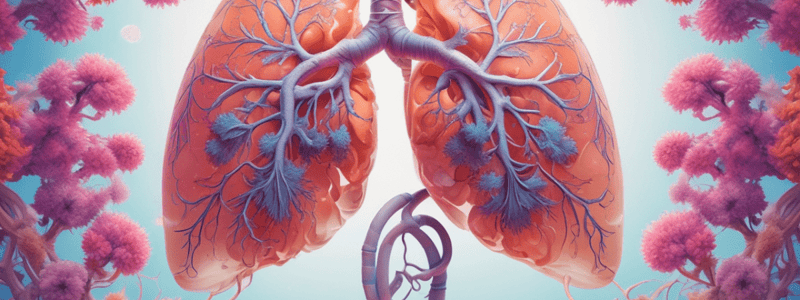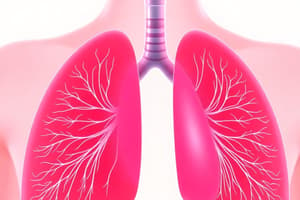Podcast
Questions and Answers
What is the function of surfactant in the lungs?
What is the function of surfactant in the lungs?
- It decreases the compliance of the lungs.
- It increases the resistance of the airways.
- It helps the alveoli expand during inhalation. (correct)
- It causes the alveoli to collapse during exhalation.
What is the name of the condition where the lung tissue collapses, resulting in a loss of volume during expansion?
What is the name of the condition where the lung tissue collapses, resulting in a loss of volume during expansion?
- Atelectasis (correct)
- Chronic obstructive pulmonary disease (COPD)
- Emphysema
- Pulmonary fibrosis
Which of the following is responsible for monitoring the body's oxygen demand and carbon dioxide levels and signaling the respiratory system to respond?
Which of the following is responsible for monitoring the body's oxygen demand and carbon dioxide levels and signaling the respiratory system to respond?
- The diaphragm
- The brainstem (correct)
- The pulmonary capillaries
- The intercostal muscles
What is the primary function of the respiratory center in the brain?
What is the primary function of the respiratory center in the brain?
What is the role of the peripheral chemoreceptors in the respiratory system?
What is the role of the peripheral chemoreceptors in the respiratory system?
What is the process by which oxygen is transported from the alveoli to the blood in the pulmonary capillaries?
What is the process by which oxygen is transported from the alveoli to the blood in the pulmonary capillaries?
What is the normal respiratory rate range for a resting adult?
What is the normal respiratory rate range for a resting adult?
What is the name of the muscle that separates the chest cavity from the abdominal cavity and is controlled by the autonomic nervous system?
What is the name of the muscle that separates the chest cavity from the abdominal cavity and is controlled by the autonomic nervous system?
What is the name of the volume of air expelled after a typical breath?
What is the name of the volume of air expelled after a typical breath?
What is the name of the pressure or opposition of the tissues in the airway to the flow of air?
What is the name of the pressure or opposition of the tissues in the airway to the flow of air?
Where are the vocal cords located?
Where are the vocal cords located?
Which structure is primarily responsible for gas exchange in the body?
Which structure is primarily responsible for gas exchange in the body?
How many lobes does the right lung have?
How many lobes does the right lung have?
What is the function of the upper airway in the respiratory system?
What is the function of the upper airway in the respiratory system?
Which part of the respiratory system is responsible for bronchoconstriction and bronchodilation?
Which part of the respiratory system is responsible for bronchoconstriction and bronchodilation?
What divides into bronchial tubes within the lungs?
What divides into bronchial tubes within the lungs?
Where is pleural fluid produced to enable smooth lung expansion and contraction?
Where is pleural fluid produced to enable smooth lung expansion and contraction?
What are the air-filled sacs primarily responsible for gas exchange in the body?
What are the air-filled sacs primarily responsible for gas exchange in the body?
What is the location of the pleural cavity with respect to the lungs?
What is the location of the pleural cavity with respect to the lungs?
What structures warm, filter, and humidify air taken in through the nose and mouth?
What structures warm, filter, and humidify air taken in through the nose and mouth?
What is the term used to describe the amount of air remaining in the lungs after maximal expiration?
What is the term used to describe the amount of air remaining in the lungs after maximal expiration?
Which of the following is NOT a factor that affects stroke volume?
Which of the following is NOT a factor that affects stroke volume?
What is the term used to describe the maximum amount of air that can be expelled from the lungs after maximal inspiration?
What is the term used to describe the maximum amount of air that can be expelled from the lungs after maximal inspiration?
Which of the following statements about the Frank–Starling mechanism is correct?
Which of the following statements about the Frank–Starling mechanism is correct?
What is the term used to describe the volume of blood pumped by the left ventricle in 1 minute?
What is the term used to describe the volume of blood pumped by the left ventricle in 1 minute?
Which of the following structures is the first to receive the electrical impulse during the cardiac conduction cycle?
Which of the following structures is the first to receive the electrical impulse during the cardiac conduction cycle?
What is the term used to describe the amount of resistance or force that the left ventricle must work against to eject blood?
What is the term used to describe the amount of resistance or force that the left ventricle must work against to eject blood?
What is the term used to describe the amount of blood in the left ventricle at the end of diastole prior to the next contraction?
What is the term used to describe the amount of blood in the left ventricle at the end of diastole prior to the next contraction?
What is the term used to describe the amount of air that can be expelled from the lungs in 1 second during forced expiration?
What is the term used to describe the amount of air that can be expelled from the lungs in 1 second during forced expiration?
Which of the following heart sounds is heard when the mitral and tricuspid valves close during systole?
Which of the following heart sounds is heard when the mitral and tricuspid valves close during systole?
Flashcards are hidden until you start studying




